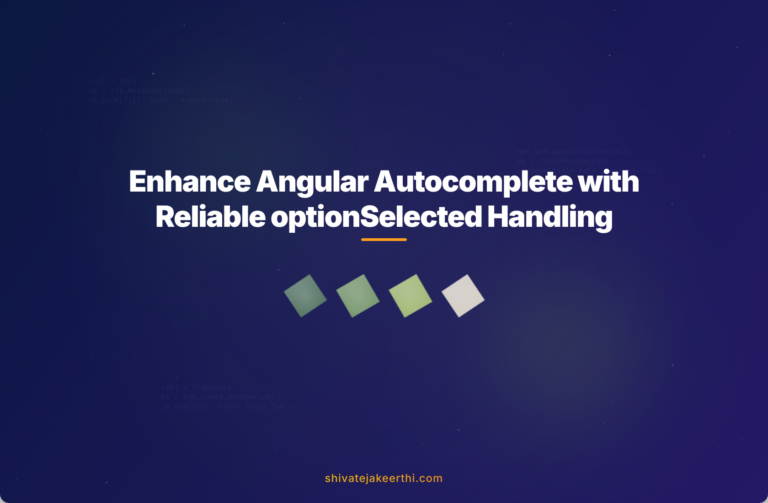When working on Angular Material, you’ve likely stumbled across the tricky behavior of the blur event firing unexpectedly. This often happens when users pick an option from an autocomplete dropdown, causing confusion and unintended side effects in the UI.
The Angular Material autocomplete is an incredibly handy component, giving users the flexibility to type their own entries or choose an existing option. However, a subtle issue surfaces when using the autocomplete feature—specifically, the unexpected triggering of the blur event on selecting an option from the dropdown (mat-option).
Imagine your app requires capturing two distinct states: one when a user manually exits the input field (blur) and another when the user selects autocomplete options. Ideally, selecting an option from mat-option shouldn’t trigger your blur-related logic. But here’s where the confusion starts—Angular Material autocomplete has been known to trigger blur events even on mat-option selection.
This issue happens because, under the hood, clicking a mat-option temporarily removes focus from your input field. Consequently, the standard HTML blur event executes unintentionally. Developers often notice this when trying to implement separate behaviors for option selection and manual input focus loss.
Initially, developers seeking a solution might come across outdated GitHub discussions suggesting relying on the event’s relatedTarget property. However, relatedTarget behaves differently across browsers—and worse, newer Angular versions handle events slightly differently. The older solutions once found on GitHub discussions or Stack Overflow questions about Angular blur events may no longer be relevant.
In older Angular Material solutions, developers used code snippets similar to:
inputBlur(event) {
if (event.relatedTarget) {
return; // Skip blur if clicked on autocomplete options
}
this.onInputBlur(); // Execute blur logic otherwise
}
However, this method no longer reliably works, as Angular and browsers have evolved, breaking such logic across multiple scenarios. Thus, we need a different solution that is reliable and robust in modern Angular scenarios.
Exploring Alternative Methods to Prevent Blur Event on Option Selection
To address this issue properly, consider handling whether a mat-option selection occurred separately from blur events. One effective and modern solution involves using Angular’s event binding directly on the autocomplete options (mat-option). Specifically, leveraging Angular Material events through separate event emitters like optionSelected.
Here’s an effective solution that works smoothly in Angular Material’s modern versions:
First, define the autocomplete options clearly in your template:
<mat-form-field>
<input matInput placeholder="Select option" [matAutocomplete]="auto"
(blur)="onBlur()">
<mat-autocomplete #auto="matAutocomplete" (optionSelected)="optionSelected($event)">
<mat-option *ngFor="let item of items" [value]="item">{{ item }}</mat-option>
</mat-autocomplete>
</mat-form-field>
Then, add clear methods in your TypeScript component file:
selectedFromAutocomplete = false;
optionSelected(event) {
this.selectedFromAutocomplete = true;
console.log("Option selected:", event.option.value);
}
onBlur() {
if (this.selectedFromAutocomplete) {
this.selectedFromAutocomplete = false;
return; // Skip actual blur logic as selection already occurred
}
console.log("Input blurred manually without selecting an option");
// Add your blur event logic here
}
With this solution, the blur event will execute the correct logic only when the user leaves the input field explicitly. Selecting a mat-option will reliably bypass blur logic, thanks to the Matform Autocomplete’s built-in optionSelected event.
We tested this approach in live Angular examples hosted on platforms like StackBlitz. Testing this solution is as simple as opening your browser’s developer console and verifying logs. You’ll see messages clearly showing whether an option was selected or if your input lost focus manually.
This approach ensures consistency and clarity, giving you confidence in your application’s event handling logic. It prevents unnecessary UI side effects or unexpected user experience issues. Proper event handling becomes especially critical in sophisticated applications that rely heavily on interactive UI components.
Best Practices for Angular Material Event Handling
To prevent event-triggering mishaps like this blur issue, keep these best practices in mind for your Angular Material applications:
- Use Built-in APIs: Always start with Angular Material’s built-in events and methods such as (optionSelected), (opened), and (closed). This ensures proper adherence to Angular’s lifecycle hooks and Material’s internal logic.
- State Management: Managing state clearly, such as using flags or properties (like our selectedFromAutocomplete), can simplify logic for complex interactions.
- Consistent Event Logic: Keep event handling logic focused and straightforward—too much interaction between different events can cause tricky UI bugs and confusion.
- Testing and Verification: Regularly test event handling logic through browser console and inspector tools, especially after Angular or Material upgrades.
- Stay Updated: Angular evolves rapidly. Regularly reference Angular Material official docs and trusted community resources like Stack Overflow to stay current with best practices.
Remember, event handling issues like this aren’t uncommon—they’re a natural part of UI development. Staying informed, frequently testing solutions, and leveraging community-shared solutions will help you quickly overcome common Angular Material challenges.
Angular provides many powerful features, but harnessing its full potential requires careful handling of events and lifecycle hooks. Mismanagement may cause subtle bugs and inconsistent user experiences.
Event handling complexities go beyond just blur events. Developers frequently struggle with Angular change detection, DOM manipulation subtleties, or JavaScript event propagation intricacies. Practicing clear state management, testing rigorously, and utilizing Angular Material’s provided event emitters solves many such hurdles.
Managing blur events properly in your Angular Material application’s autocomplete fields streamlines user interactions significantly. This straightforward solution keeps events clear, logical, and intuitive—enabling you to focus on delivering a seamless UI.
Proper event handling not only enhances user experience but also improves code maintainability and readability, critical to large-scale applications or collaborative coding environments.
Have you encountered similar tricky Angular Material problems? If so, what approaches did you find effective in resolving them? Share your experiences or questions in the comments below—together we can tackle Angular Material intricacies more effectively!



0 Comments